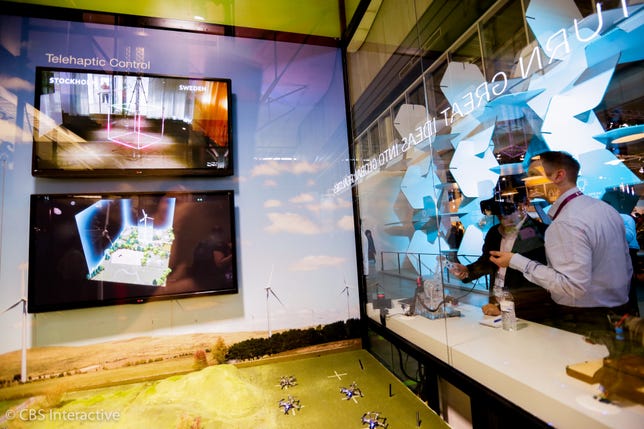Cellular connection or not, I am not a good drone pilot.
That’s what I learned from my brief time at telecom-gear maker Ericsson’s booth at the Mobile World Congress trade show last week in Barcelona. I had a chance to pilot a drone more than 1,400 miles away in Stockholm with the help of an Oculus Rift virtual-reality headset and a 4G cellular network.
The uber-long-distance flight was awkward. Small delays between my hands moving the controls and the response of the quadcopter made for a sluggish experience. The video feed was laggy as it streamed footage of the drone into my headset via 4G.


I wore an Oculus Rift headset to view the position of the drone in Stockholm. The video feed and controls ran through a 4G network.
Sarah Tew/CNET
But that was part of the point of the demonstration, which showed off the potential benefits, as well as the limitations, of adding a cellular connection to drones. Pairing wireless technology with drones was one of the key themes at this year’s Mobile World Congress, based on the belief that the two could combine to let the aerial vehicles fly higher, farther and safer than ever.
Most of today’s drones are controlled via short-range signals like Wi-Fi, Bluetooth or radio airwaves. In contrast, military pilots for years have routinely flown Predator and Reaper drones in far-flung places like Iraq and Afghanistan from a base in Nevada. By tapping a nationwide cellular network, a consumer drone could theoretically go as far as its batteries will let it.
Adding cellular connectivity to drones also opens the door to new possibilities. Such a connection lets a drone send and receive data, including the positions of nearby objects, allowing it to fly around buildings, natural obstructions and even other connected drones. Companies are largely interested in the business implications of a connected drone, such as sending one up to repair an out-of-reach cellular tower.
“I can see more and more of those use cases with drones,” said Chris Penrose, who heads up connected devices at AT&T. His company and Intel said at the show that they are working together to add 4G to drones.
Bumpy ride
The drone demonstration was all about showing off the haptic feedback capabilities of the custom controller, which looked like a miniature, flexible construction crane. You grip one end and manipulate it to steer the quadcopter.
The haptic feedback is similar in principle to the vibration you feel when tapping your iPhone’s 3D Touch, but far more forceful.


That’s me in the VR headset, flying the drone. You can see the position of the drone in Stockholm on the top screen.
Sarah Tew/CNET
If the quadcopter, which is small enough to fit in your hand, flies close to a predetermined virtual border, the controller will actually resist your motion to continue moving in that direction. Technicians with Sweden-based Ericsson had set up a glowing, see-through cube in Stockholm. The point of the demo was to fly the drone above the cube and enter from the top. Flying toward the sides would only trigger the virtual wall, causing the controller to push back.
I never actually got the drone into the cube because it was difficult for me to assess the depth of the space. It didn’t help that feedback came a little slow.
That’s a limitation of 4G, which lacks real-time responsiveness. With a next-generation 5G network, the delay between when you send a signal and when you get a response, known as latency, drops significantly. Industry executives often give the example of a surgeon in one city performing an operation with robotic hands in another city, with 5G powering a real-time response.
To prove this point, Ericsson had quadcopters connected to a “simulated” 5G network, which is limited and only designed to show off the reduction in latency. The drones, which were inches in front of me, responded perfectly as they flew near a miniature wind turbine. As the drones got closer to the turbine, the haptic feedback kicked in and prevented me from forcing them to go farther.
Brave new world?
While drones are hot ticket items for consumers, lots of questions remain about where they should be flown and how they should be used. On one hand, extending the range of these aerial vehicles can greatly help businesses with equipment maintenance or security monitoring. On the other hand, camera-equipped drones that can be operated from anywhere open the door for potential abuse and the violation of personal privacy.
No one has figured out just the right balance, not even the Federal Aviation Administration, which is still working out the rules for long-distance travel.


Now playing:
Watch this:
Parrot Disco fixed-wing drone (almost) takes to the sky
1:09
Related stories
- Drones in 2015 move from ‘wow, that’s neat’ to ‘uh-oh’
- Drone owners must register with FAA, starting December 21
- Drones 101: Where can I fly my drone?
But the technology is coming. AT&T said it’s working with Intel now in the hope that more regulatory direction will be coming down the line.
A connected drone could be smart enough to know to avoid certain areas. For example, Penrose said, you could write a program to direct drones away from cellular dead zones. It wouldn’t be much of a stretch to include airports or private residences. Add the haptic feedback, and you have one method of preventing nefarious actions.
“Flying things over a mobile network allows for several ways to restrict where a quadcopter can fly or what it can film,” Norlin said.
Here’s hoping I get a virtual wall erected around my home before long-distance drones take to the skies.



